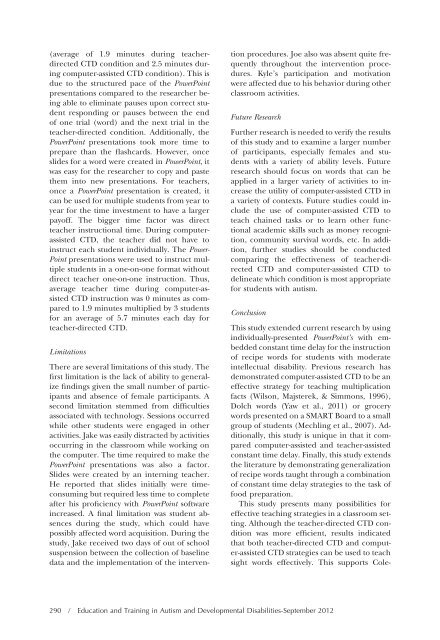etadd_47(3) - Division on Autism and Developmental Disabilities
etadd_47(3) - Division on Autism and Developmental Disabilities
etadd_47(3) - Division on Autism and Developmental Disabilities
Create successful ePaper yourself
Turn your PDF publications into a flip-book with our unique Google optimized e-Paper software.
(average of 1.9 minutes during teacherdirected<br />
CTD c<strong>on</strong>diti<strong>on</strong> <strong>and</strong> 2.5 minutes during<br />
computer-assisted CTD c<strong>on</strong>diti<strong>on</strong>). This is<br />
due to the structured pace of the PowerPoint<br />
presentati<strong>on</strong>s compared to the researcher being<br />
able to eliminate pauses up<strong>on</strong> correct student<br />
resp<strong>on</strong>ding or pauses between the end<br />
of <strong>on</strong>e trial (word) <strong>and</strong> the next trial in the<br />
teacher-directed c<strong>on</strong>diti<strong>on</strong>. Additi<strong>on</strong>ally, the<br />
PowerPoint presentati<strong>on</strong>s took more time to<br />
prepare than the flashcards. However, <strong>on</strong>ce<br />
slides for a word were created in PowerPoint, it<br />
was easy for the researcher to copy <strong>and</strong> paste<br />
them into new presentati<strong>on</strong>s. For teachers,<br />
<strong>on</strong>ce a PowerPoint presentati<strong>on</strong> is created, it<br />
can be used for multiple students from year to<br />
year for the time investment to have a larger<br />
payoff. The bigger time factor was direct<br />
teacher instructi<strong>on</strong>al time. During computerassisted<br />
CTD, the teacher did not have to<br />
instruct each student individually. The Power-<br />
Point presentati<strong>on</strong>s were used to instruct multiple<br />
students in a <strong>on</strong>e-<strong>on</strong>-<strong>on</strong>e format without<br />
direct teacher <strong>on</strong>e-<strong>on</strong>-<strong>on</strong>e instructi<strong>on</strong>. Thus,<br />
average teacher time during computer-assisted<br />
CTD instructi<strong>on</strong> was 0 minutes as compared<br />
to 1.9 minutes multiplied by 3 students<br />
for an average of 5.7 minutes each day for<br />
teacher-directed CTD.<br />
Limitati<strong>on</strong>s<br />
There are several limitati<strong>on</strong>s of this study. The<br />
first limitati<strong>on</strong> is the lack of ability to generalize<br />
findings given the small number of participants<br />
<strong>and</strong> absence of female participants. A<br />
sec<strong>on</strong>d limitati<strong>on</strong> stemmed from difficulties<br />
associated with technology. Sessi<strong>on</strong>s occurred<br />
while other students were engaged in other<br />
activities. Jake was easily distracted by activities<br />
occurring in the classroom while working <strong>on</strong><br />
the computer. The time required to make the<br />
PowerPoint presentati<strong>on</strong>s was also a factor.<br />
Slides were created by an interning teacher.<br />
He reported that slides initially were timec<strong>on</strong>suming<br />
but required less time to complete<br />
after his proficiency with PowerPoint software<br />
increased. A final limitati<strong>on</strong> was student absences<br />
during the study, which could have<br />
possibly affected word acquisiti<strong>on</strong>. During the<br />
study, Jake received two days of out of school<br />
suspensi<strong>on</strong> between the collecti<strong>on</strong> of baseline<br />
data <strong>and</strong> the implementati<strong>on</strong> of the interven-<br />
ti<strong>on</strong> procedures. Joe also was absent quite frequently<br />
throughout the interventi<strong>on</strong> procedures.<br />
Kyle’s participati<strong>on</strong> <strong>and</strong> motivati<strong>on</strong><br />
were affected due to his behavior during other<br />
classroom activities.<br />
Future Research<br />
Further research is needed to verify the results<br />
of this study <strong>and</strong> to examine a larger number<br />
of participants, especially females <strong>and</strong> students<br />
with a variety of ability levels. Future<br />
research should focus <strong>on</strong> words that can be<br />
applied in a larger variety of activities to increase<br />
the utility of computer-assisted CTD in<br />
a variety of c<strong>on</strong>texts. Future studies could include<br />
the use of computer-assisted CTD to<br />
teach chained tasks or to learn other functi<strong>on</strong>al<br />
academic skills such as m<strong>on</strong>ey recogniti<strong>on</strong>,<br />
community survival words, etc. In additi<strong>on</strong>,<br />
further studies should be c<strong>on</strong>ducted<br />
comparing the effectiveness of teacher-directed<br />
CTD <strong>and</strong> computer-assisted CTD to<br />
delineate which c<strong>on</strong>diti<strong>on</strong> is most appropriate<br />
for students with autism.<br />
C<strong>on</strong>clusi<strong>on</strong><br />
This study extended current research by using<br />
individually-presented PowerPoint’s with embedded<br />
c<strong>on</strong>stant time delay for the instructi<strong>on</strong><br />
of recipe words for students with moderate<br />
intellectual disability. Previous research has<br />
dem<strong>on</strong>strated computer-assisted CTD to be an<br />
effective strategy for teaching multiplicati<strong>on</strong><br />
facts (Wils<strong>on</strong>, Majsterek, & Simm<strong>on</strong>s, 1996),<br />
Dolch words (Yaw et al., 2011) or grocery<br />
words presented <strong>on</strong> a SMART Board to a small<br />
group of students (Mechling et al., 2007). Additi<strong>on</strong>ally,<br />
this study is unique in that it compared<br />
computer-assisted <strong>and</strong> teacher-assisted<br />
c<strong>on</strong>stant time delay. Finally, this study extends<br />
the literature by dem<strong>on</strong>strating generalizati<strong>on</strong><br />
of recipe words taught through a combinati<strong>on</strong><br />
of c<strong>on</strong>stant time delay strategies to the task of<br />
food preparati<strong>on</strong>.<br />
This study presents many possibilities for<br />
effective teaching strategies in a classroom setting.<br />
Although the teacher-directed CTD c<strong>on</strong>diti<strong>on</strong><br />
was more efficient, results indicated<br />
that both teacher-directed CTD <strong>and</strong> computer-assisted<br />
CTD strategies can be used to teach<br />
sight words effectively. This supports Cole-<br />
290 / Educati<strong>on</strong> <strong>and</strong> Training in <strong>Autism</strong> <strong>and</strong> <strong>Developmental</strong> <strong>Disabilities</strong>-September 2012

















